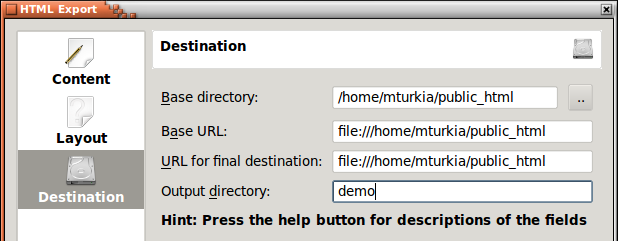On the destination page you specify several directories and URL's specifying where your pages go.
The philosophy is that you specify a base directory for all your generations, and for each generation specify a new subdirectory.
First you need to specify the base directory for all your images. This directory will be remembered from session to session, and allows you to once and for all tell where all subsequent images should go. Here you may specify a directory, or any protocol supported by KDE. Examples includes:
ftp://someserver/my-upload-area/images (upload using FTP)
fish://someserver/home/foo/images (upload using ssh)
smb://someserver/c/images (upload to a Windows share)
Once you are done generating your images, you may want to check whether they are really available to your audience. If you specify a URL in the Base URL line edit, a web browser will be spawned once HTML pages has been generated. The URL you specify here should match the directory you specified above. Thus the web browser will be started on the subdirectories of this URL.
Once you have generated HTML pages, your pages may still not be in their final destination, you may still need special upload procedures out of the control of KPhotoAlbum. For the Import feature (see Chapter 8, Import/Exporting) to work, you need to specify the final destination of the pages. Again this does not include the subdirectory of the current generation.
The three line edits described above are all base directories and base URL's. At these locations a new subdirectory will be created named with the name you specify in Output Directory.
